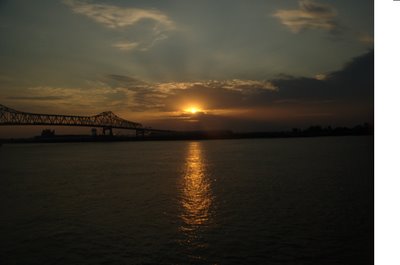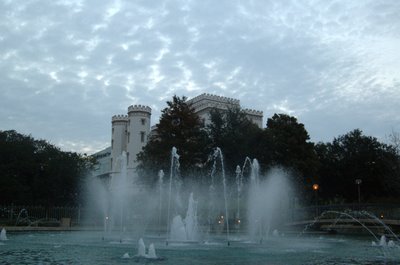Camera lenses may be of diffrent types:
- Wide angle lenses have a shorter focal length, and give a more real life perspective. They make it appear as if closer objects look large in relation to those in the background. Viewers feel a sense of involvement. The camera elements of a wide angle lens float inside their housing. The depth of field is relatively large while perspective is exaggerated.
- Telephoto lenses magnigy the distance subject and give more of a flattening effect
- Mirror lenses geneate a similar effect to telephoto but use a combination of mirrors and lenses to do this
- Zoom lenses cover a variety of focal lengths.
- Macro lens on the other hand has the ability to focus closely and give magnified views of the small subjects. Many zoom lenses themselves have a macro facility
Monday, December 11, 2006
Saturday, November 18, 2006
Wild Flower Wild As You Can Be
(Excerpt taken from The Book of Photography, by John Hedgecoe, Alfred Knopfe)
Photography includes three very essential elements - shape, color and tone. These are combined to yield texture, pattern and form. These combinations will allow viewers o grasp the emotions and contexts underlying the photograph. Shape allows us to identify the subject, tone describes the degree of contrast between light and dark areas. Color can also be used to create contrasts and helps to evoke emotional response. Pattern is simply a repitition of any particular aspect of the photograph in a regular manner. Shape and color can help to accentuate the pattern. Texture makes the subject real and touchable. Form gives the 3 Dimensional effect to a photograph
 Observe the photograph of this flower. It has the necessary shape the tells us it is a flower, the vibrant colors along with tone give it a shape that reaches out to you, there are no repetitive patterns but you can definitely feel the texture, dont you just wanna touch it?.....This close up has come surprsingly well considering the fact that I was using the default 18mm lens that came with my Nikon. I would really love to get a better macro lens to do more close ups. Any suggestions anyone for a good lens of the macro/micro category?
Observe the photograph of this flower. It has the necessary shape the tells us it is a flower, the vibrant colors along with tone give it a shape that reaches out to you, there are no repetitive patterns but you can definitely feel the texture, dont you just wanna touch it?.....This close up has come surprsingly well considering the fact that I was using the default 18mm lens that came with my Nikon. I would really love to get a better macro lens to do more close ups. Any suggestions anyone for a good lens of the macro/micro category?
Photography includes three very essential elements - shape, color and tone. These are combined to yield texture, pattern and form. These combinations will allow viewers o grasp the emotions and contexts underlying the photograph. Shape allows us to identify the subject, tone describes the degree of contrast between light and dark areas. Color can also be used to create contrasts and helps to evoke emotional response. Pattern is simply a repitition of any particular aspect of the photograph in a regular manner. Shape and color can help to accentuate the pattern. Texture makes the subject real and touchable. Form gives the 3 Dimensional effect to a photograph
 Observe the photograph of this flower. It has the necessary shape the tells us it is a flower, the vibrant colors along with tone give it a shape that reaches out to you, there are no repetitive patterns but you can definitely feel the texture, dont you just wanna touch it?.....This close up has come surprsingly well considering the fact that I was using the default 18mm lens that came with my Nikon. I would really love to get a better macro lens to do more close ups. Any suggestions anyone for a good lens of the macro/micro category?
Observe the photograph of this flower. It has the necessary shape the tells us it is a flower, the vibrant colors along with tone give it a shape that reaches out to you, there are no repetitive patterns but you can definitely feel the texture, dont you just wanna touch it?.....This close up has come surprsingly well considering the fact that I was using the default 18mm lens that came with my Nikon. I would really love to get a better macro lens to do more close ups. Any suggestions anyone for a good lens of the macro/micro category?
Wednesday, November 15, 2006
Fiery Sunset

An incredible sunset along the Mississippi. All I can comment about this picture is...well...damn it is beautiful.
Here is a small trivia about light meters, the most important tool of a photographer that helps to identify the right amount of light falling on the lens, from the subject. Did you know that earliest light meters worked by compaing the available light with a light source like a bulb and the greatest advance was made when it was discovered that selenium generated an electric current when activated by light, this was the introduction of the selenium cell.
Tuesday, November 14, 2006
Red Vines on a Tall Tree
 One of the beutiful things about using a digital camera is that the owner develops a new found eye to recognize color in nature. I have never before seen such vivid colors in nature as I have been doing so far. This is one such good example.
One of the beutiful things about using a digital camera is that the owner develops a new found eye to recognize color in nature. I have never before seen such vivid colors in nature as I have been doing so far. This is one such good example.Depth of field is an important criteria to consider. It controls how much in focus farther off items are in your photograph. Increasing the f stop value will increase the depth of field, but you need to change the exposure appropriately to allow the light to fall on the film.
Sunday, November 12, 2006
Ray of Hope
 Another great sunset picture. The main focus of this picture was the reflection of the sunlight falling on the water. One of the core issues in photography is when you have contrasting bright and dark locations when a snap is taken. Using a SLR it can be tricky to obtain the correct aperture and f stop when taking a picture of both dark and light regions. One solution is to focus on the lighter section , click the button and move the camera to the darker region and take a picture or vice versa. This trick enables camera lock on one section of the subject, and use this setting for the other parts of the subject. Of course this method has to be used with care.
Another great sunset picture. The main focus of this picture was the reflection of the sunlight falling on the water. One of the core issues in photography is when you have contrasting bright and dark locations when a snap is taken. Using a SLR it can be tricky to obtain the correct aperture and f stop when taking a picture of both dark and light regions. One solution is to focus on the lighter section , click the button and move the camera to the darker region and take a picture or vice versa. This trick enables camera lock on one section of the subject, and use this setting for the other parts of the subject. Of course this method has to be used with care.Wednesday, November 08, 2006
A castle, haunted but brilliant

A real life haunted castle in Baton Rouge with a ghost buster style action in the skies!!....Observe the incredible action in the skies. Light plays a major role in any photograph you take with a digital camera. This photo was taken around evening when the sun light was low in the sky and cast a beautiful light that looks as if the sky itself is mesmerizingly haunted.
The Moon and the darkness

An effective picture with a Nikon can be taken only through experimentation. I experimented with my aperture and f-stop to allow the right amount of exposure in order to take this beautiful picture of the moon shining through the trees. A full moon would have been better, but oh well, one can take only what is given to you at the given time.
Tracks of Freedom

I'm starting off my blogospheric experience with the first snap i took with my brand new Nikon D50. I have started on that incredible journey towards digital freedom and expression. This is a photograph taken from a 18 mm lens. I took this picture around around evening time and used GIMP to provide a black and white texture to this image. One thing I like about this image is the perspective view, with incredible detail being shown at the nearer end of the digital camera, and more blurred far off perspective towards the horizon.
Subscribe to:
Posts (Atom)
